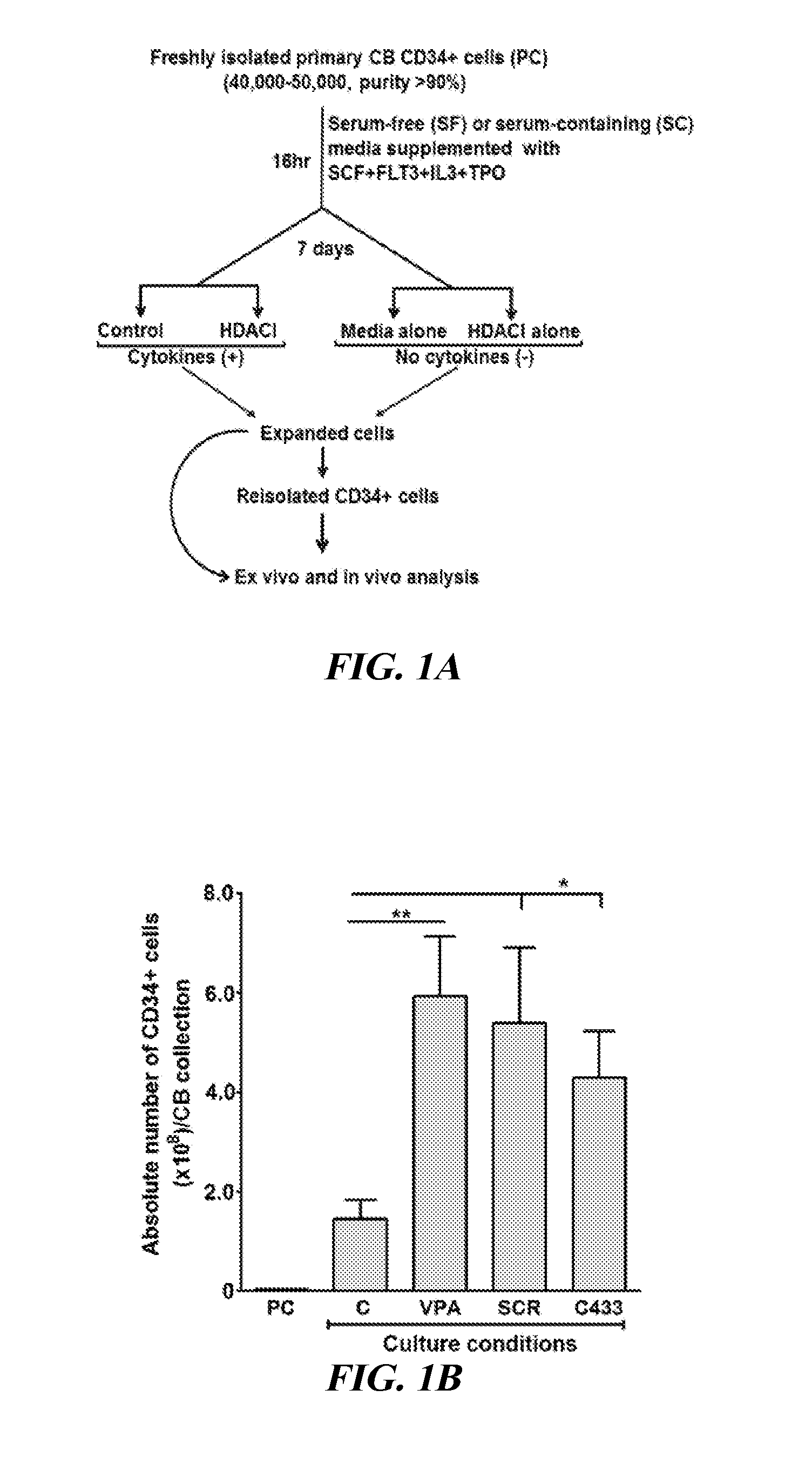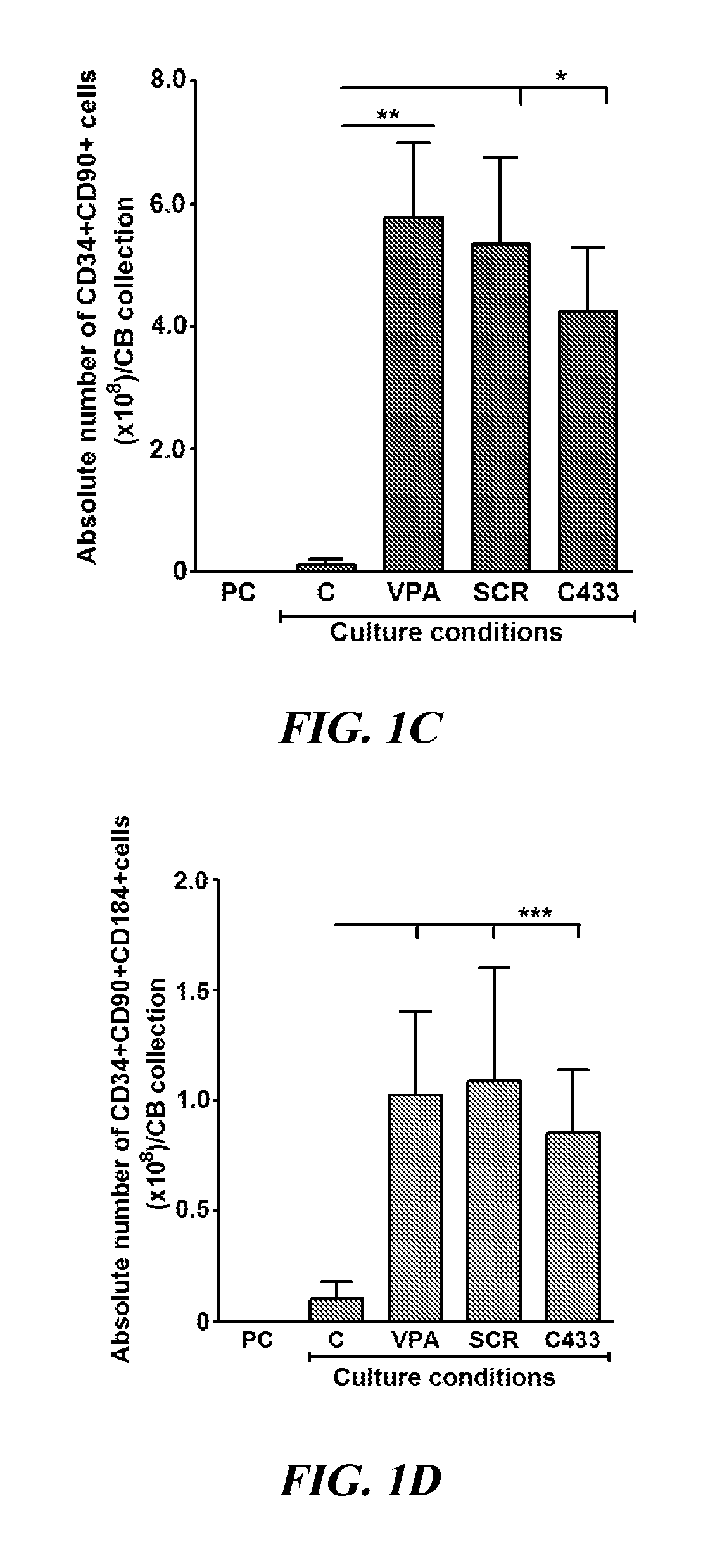Enriched and expanded human cord blood stem cells for treatment of hematological disorders
a human cord blood and stem cell technology, applied in the field of enriched and expanded human cord blood stem cells, can solve the problems of unacceptably high graft failure rate and delayed engraftment kinetics in adult recipients, and achieve the effects of increasing the expression of cd90 and aldehyde dehydrogenase activity
- Summary
- Abstract
- Description
- Claims
- Application Information
AI Technical Summary
Benefits of technology
Problems solved by technology
Method used
Image
Examples
example 1
Epigenetic Reprogramming Induces the Expansion of Cord Blood Stem Cells
[0081]Methods
[0082]Isolation of CB CD34+ Cells and their Ex Vivo Culture
[0083]CB collections were purchased from the Placental Blood Program at the New York Blood Center. CB-MNCs were isolated by Ficoll-Hypaque density centrifugation, and CD34+ cells were purified by immunotnagnetic selection as previously described (Chaurasia et al., “Chromatin-Modifying Agents Promote the Ex vivo Production of Functional Human Erythroid Progenitor Cells,”Blood 117:4632-4641 (2011), which is hereby incorporated by reference in its entirety). Highly purified (90%-98%) PCs (4.0-5.0×104) were cultured in SF Stemline II (Sigma-Aldrich) culture medium or IMDM (Lonza) containing 30% FBS (HyClone Laboratories) supplemented with 150 ng / ml SCF, 100 ng / ml fms-like tyrosine kinase receptor 3 (FLT3 ligand), 100 ng / ml thrombopoietin (TPO), and 50 ng / ml interleukin 3 (IL-3) (R&D Systems) and incubated in a humidified incubator maintained at 3...
example 2
Effect of HDACIs on the Absolute Number of BFU-E+CFU-Mix
[0150]Purified ALDH+CD34+ cells generated using SF cultures supplemented with VPA generated greater absolute numbers of BFU-E and CFU-Mix (8.4×107±6.7×10′ / CB collection) as compared to SC cultures (1.4×107±0.88×107; ANOVA, p=0.001) (FIG. 20A). By contrast, ALDH-CD34+ cells from SC cultures supplemented with VPA generated greater numbers of BFU-E and CFU-Mix (2.7×106±1.0×106) as compared to SF cultures (3.5×105±0.78×105) (ANOVA, p=0.01) (FIG. 20B). These data indicate that serum differentially influences the in vitro fate of ALDH+ and ALDH-cell populations.
example 3
Effect of Cryopreservation on Stem Cell Phe Phenotype
[0151]Since it is anticipated that the expanded HSC product will be cryopreserved prior to its delivery to a transplant center, the effects of cryopreservation on the recovery of viable cells expressing the HSC phenotype was explored. CB-CD34+ cells were treated with VPA for 7 days and the cell numbers were enumerated and phenotypic analyses were performed both prior to and post thaw. Cryopreservation was performed using Synth-a-Freeze from Invitrogen (Life Technologies, Grand Island, N.Y.).
[0152]Synth-a-Freeze is a defined, liquid cryopreservation medium containing 10% dimethylsulfoxide (DMSO). Synth-a-Freeze does not contain antibiotics, antimycotics, hormones, growth factors, serum, or proteins. This medium is HEPES and bicarbonate buffered. The percentages of CD34+, CD34+CD90+ and CD34+CD90+CD184+ cells were not altered significantly pre and post cryopreservation (90%-95% cells remained viable). The absolute number of cells ex...
PUM
| Property | Measurement | Unit |
|---|---|---|
| concentration | aaaaa | aaaaa |
| concentration | aaaaa | aaaaa |
| temperature | aaaaa | aaaaa |
Abstract
Description
Claims
Application Information
 Login to View More
Login to View More - R&D
- Intellectual Property
- Life Sciences
- Materials
- Tech Scout
- Unparalleled Data Quality
- Higher Quality Content
- 60% Fewer Hallucinations
Browse by: Latest US Patents, China's latest patents, Technical Efficacy Thesaurus, Application Domain, Technology Topic, Popular Technical Reports.
© 2025 PatSnap. All rights reserved.Legal|Privacy policy|Modern Slavery Act Transparency Statement|Sitemap|About US| Contact US: help@patsnap.com



